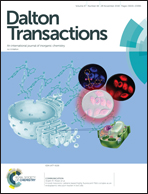Abstract
This article compares the reactivity patterns of β-ketoiminate (AcNac) and β-thioacetyliminate (SacNac), with special reference to the unsymmetrical β-diketiminate (NacNac), on the selective {Ru(acac)2} metal platform that encompasses the electronically rich acac (= acetylacetonate) moiety. In this regard, structural and spectroelectrochemical aspects have been reported for the newly designed complexes [RuIII(acac)2(AcNacR)] (1a–1c), [RuIII(acac)2(SacNacH)] (2) and [RuIII(acac)2(NacNacR)] (3a–3c) [R = para-substituents (H, Cl, OMe) of the N-bearing aryl group]. The subsequent exploration of the impact of metal chelation on the reactivity profile of the β-ketoiminate analogues revealed the following: (a) the facile oxygenation of the methine centre (Cβ–H) of the unsymmetrical NacNac in 3 led to ketodiimine (L1) in [RuII(acac)2(L1)] (4), while analogues AcNac and SacNac in 1 and 2, respectively, remained resistant to oxidative functionalisation due to their relatively lower charge densities at the methine (Cβ) centres. (b) Hydrolysis of the relatively weak C–S bond of SacNac resulted in a μ3-S bridged [{Ru(acac)2}3(μ3-S)] complex (2′). (c) Unlike 2 and 3, AcNac in 1 underwent an interesting transformation selectively in a non-polar solvent (toluene) to the 3-acetyl AcNac (L2−) moiety in 5 ([RuIII(acac)2(L2)]) via the generation of a new C–C bond at its backbone, indicating the ambiphilic feature of AcNac. The paper also addresses the aforesaid transformation processes and fractional redox non-innocence of AcNac, SacNac and NacNac in 1n, 2n and 3n (n = +1, 0, −1), respectively.



 Please wait while we load your content...
Please wait while we load your content...